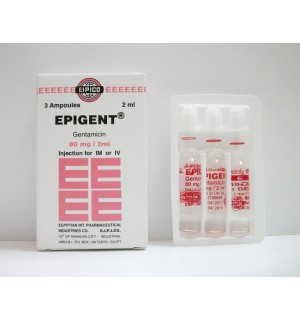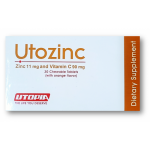
Epigent Ampoules
The Aminoglycoside Antibiotic
Composition :
Each ampoule contains:
Gentamicin (as sulphate) 20 or 80 mg
Properties :
EPIGENT (gentamicin) is an aminoglycoside bactericidal antibiotic which inhibits bacterial protein synthesis. It has a broad-spectrum of activity against gram-negative and gram-positive organisms including: Brucella species, Escherichia coli, klebsiella species, Proteus species, Providencia soecres, Pseudomonas aeruginosa, Enterobacter species, Serratia species, Citrabaeter species. Vibrio, Yersinia, and Staphylococcus aureus.
Pharmacokinetics :
Gentamicin is rapidly absorbed after IM injection. The drug is widely distributed to various sites; CSF penetration is low even in patients with inflamed meninges. Higher levels are achieved in CSF of the new boms than in adults. Binding of gentamicin to plasma protein is usually low. Gentamicin is not metabolized. and is excreted unchanged primarily in the urine. Small amounts may be excreted in bile. The elimination half -life for gentamicin is about 2 – 3 hours, and may be longer in neonates and patients with renal impairment.
Indications :
Treatment of severe systemic infections due to sensitive gram negative and other organisms, which include:
– Bacterial neonatai sepsis.
– Bacterial septicemia.
– Serious bacterial infections of CNS (meningitis, ventriculitis), mainly in neonates due to better penetration across the blood- brain barrier in this age group.
– Urinary-tract infections (acute pyelonephritis).
– Biliary-tract infections (acute cholecystitis or cholangitis).
– Respiratory tract infections (pneumonia).
– Gastro-intestinal tract infections, including peritonitis.
– Infections fo skin, bone, and soft tissue, including burns and wounds.
– Brucellosis, cystic fibrosis, endocarditis, endometritis, granuloma inguinale, otitis externa, otitis media, and pelvic inflammatory disease.
– Treatment of immunocompromised patients and those in intensive care.
– In the prophylaxis of surgical infection.
– Epigent is often used concomitantly with other antibacterials to extend its spectrum of efficacy or increase its effectiveness.
Dosage and Adininistration :
Adults:
– Serious infections: 3 mglkg/day in 3 equal doses every 8 hours.
– life-threatening infections: 5 mglkg/day in 3 or 4 equal doses.
– Reduce dosage to 3 mg/l<g/day as soon as clinically Indicated.
– Doses up to 15 mglkg/day have been used in the treatment of intraocular infections.
Children: 6 – 7.5 mg/kg/day (2 – 2.5 mg/kg every 8 hours).
Infants and neonates: 7.5 mg/kg/day (2.5 mg/kg every 8 hours).
Premature or full-term neonates « 1 week of age): 5 mg/kg/day (2.5 mg/kg every 12
hours).
Duration of therapy: Usually 7 – 10 days. In difficult and complicated infections, a longer course of therapy may be necessary, in which case, renal, auditory and vestibular functions should be monitored, since toxicity is more apt to occur with treatment extended beyond 10 days. Reduce dosage if clinically indicated.
Endocarditis prophylaxis for Gl or GU procedure or surgery:
Adults: 1.5 mg/kg 1 M, or IV 30 to 60 minutes before procedure or surgery and every 8 hours after, for two doses. Give separately with aqueous penicillin or ampicillin.
Children: 2 mg /kg IM or IV 30 to 60 minutes before procedure or surgery and every 8 hours after, for two doses. Give separately with aqueous penicillin G or ampicillin G. Post·hemodialysis to maintain therapeutic blood levels:fults: 1 ·1.7 mglkg IM or by IV infusion after each dialysis.
children: 2 – 2.5 mg/kg IM or by IV infusion after each dialysis.
enet function impairment : Adjust dosage; whenever possible. monitor serum ncentrations of gentamicin. One method of dosage adjustment is to Increase the
erval between the dose administered.
Epigent may be given by IM or IV Infusion in 50 mt – 200 rnl of sterile Isotonic saline or solution of dextrose in water. In Infants and children, the volume of diluent should be Infuse over a period of Yi – 2 hours.
the dose for IV and IM administration Is identical; IV administration is useful for treating ulents with bacterial septicemia or those in shock. It may also be the preferred route for some patients with CHF, hematologlc disorders, severe burns or reduced muscle mass. A 1- 2 mg/kg loading dose may be used, followed by a maintenance dose. Epigent should be administered separately; do not mix with other drugs.
Drug Interactions :
acyctovir, amphotericin B, cisplatin, methoxyflurane, other aminoglycosides, vancomycin: crease ototoxicity and nephrotoxicity. Use together cautiously. ephalothin: Increases nephrotoxicity. Use together cautiousty; monitor renal function. Imenhydrinate: May mask symptoms of ototoxicity. Use with caution. diuretics: May increase ototoxicity. Avoid using together. general anesthetics, ineuromuscular blockers: May potentiate neuromuscular
blockade.Monitor patient closely.
indomethacin: May increase peak and trough levels of gentamicin. Monitor gentamicin vets.
iv loop diuretics (such as furosemide): Increase ototoxicity. Use cautiously.
eurotoxic agents: Increase neurotoxicity. Avoid using together.
arenteral penicillins (such as ampicillin, ticarcillin): Gentamicin inactivatkm in vitro. Don’t mix together.
Precautions :
Epigent should be used with caution in:
– Patients with impaired renal function or neuromuscular disorders.
– Conditions characterized by muscular weakness.
– Neonates, infants, and the elderly.
– Lactation; a decision should be made to discontinue therapy or nursing, taking into account the importance of the drug to the mother.
– EPIGENT is not recommended in pregnancy.
– Because of the risk of ototoxicity and nephrotoxicity, the dosage should be adjusted to void peak plasma concentrations above 10 – 12 pg} ml or trough levels above10-12 Ug/ml in Patients receiving multiple – dose regimens of EPIGET
– Regular assessment of auditory and renal function is particularly necessary In patients rceiving high doses or prolonged courses, in infants, the elderly, and in patients with impaired renal function.
Contraindications :
hypersensitivity to the product or to other aminoglycosides.
side Effects :
EPIGENT and other aminolycosldes may produce side-effects including ototoxicity, ephrotoxicity, seizures, neurotoxicity, headache, lethargy, thrombocytopenia, leucopenia, granulocytosis, hypersensitivity reactions, nausea, vomiting, and stomatitis.
Packaging :
Epigent 20 mg Ampoules: Pack of 3 ampoules of 2 ml each.
Epigent 80 mg Ampoules: Pack of 3 ampoules of 2 rnl each .
PRODUCED BY :
EGYPTIAN INT. PHARMACEUTICAL INDUSTRIES CO.
E.I. P.I. CO.
101h OF RAMADAN CITY EGYPT

